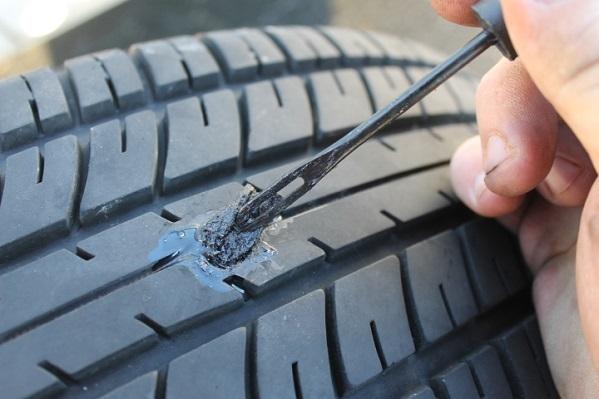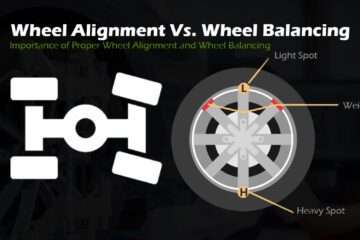A tire plug, also referred to as a plug patch or rope plug, is a temporary solution used to seal punctures in a tire. It enables you to continue driving on a damaged tire until you can have it professionally repaired or replaced. Here’s what you need to understand about the durability of a tire plug:
- What Is a Tire Plug?
- A tire plug is a rubber plug inserted into a puncture in the tire to prevent air leakage.
- It functions by directly plugging the hole created by a nail or any other object that caused the tire puncture.
- The tire plug creates an airtight seal that prevents air from escaping as you drive.
- When to Use a Tire Plug:
- Tire plugs are suitable for small punctures located within the tread area of the tire (the part that contacts the road).
- The puncture must be 1/4 inch or less in size.
- If the hole extends to the sidewall, a tire plug should not be used.
- Examples of objects causing small punctures include nails, screws, and thorns.
- Limitations and Considerations:
- Not for All Punctures: Not all types of damage are suitable for plugging a tire.
- Size Matters: Any puncture larger than 1/4 inch is not a good candidate for a plug.
- Underinflated Tires: Tire plugs should only be used if the tire has not been driven significantly underinflated or flat.
- Tread Area Damage: Cuts, slashes, or tears in the tread area should not be repaired using tire plug.
- Sidewall Punctures: Sidewall punctures or damage are unsafe to repair with a plug.
- Installation Process:
- Removing the Object: First, remove the nail or sharp object causing the puncture.
- Inserting the Tire Plug: Use an insertion tool to place a rubber stem into the punctured hole.
- Adhesive Bond: The rubber stem is coated with adhesive that bonds to the inner surface of the tire.
- Airtight Seal: After being fully inserted, the tire plug seals the hole from within the tire.
- Long-Term Risks:
- Continuing to drive on a plugged tire for an extended period can pose risks.
- The structural integrity of the tire may be compromised.
- Sudden blowouts resulting from a failed plug can pose significant dangers.
- Professional Inspection:
- Don’t push the limits. Have your tire inspected and repaired by certified tire experts.
- Tread Connection brings the tire shop to you, offering convenient repairs at your home and on your schedule.
Remember, while a tire plug provides a quick fix, it’s essential to prioritize safety and consider a proper repair or replacement for long-term peace of mind.

What are the risks of driving on a plugged tire?
Driving on a plugged tire can be convenient in the short term, but it’s essential to understand the potential risks. Here are some considerations for plugging a tire:
Risks of driving on a plugged tire |
|
|---|---|
| Risk of Blowout: | – One of the most significant dangers is the increased chance of a blowout. – If the plug fails or comes loose, it can lead to sudden air pressure loss and a potential blowout. – This situation can be extremely dangerous, especially when driving at high speeds. |
| Reduced Handling and Control: | – A plugged tire negatively impacts your vehicle’s handling and control. – Uneven wear due to the plug can affect how the tire responds during turns and braking. – Maintaining proper handling becomes challenging. |
| Damage to Wheel Rim: | – As the plugged tire continues to lose air pressure, the sidewall may deform inward and rub against the wheel rim. – This can cause damage to both the tire and the rim. – In extreme situations, it could compromise the integrity of the tire’s structure. |
| Repeated Punctures: | – A plugged tire is more prone to additional punctures and damage. – Each new puncture increases the risk of failure. – Repeated repairs can be expensive and inconvenient. |
| Limited High-Speed Capability: | – Driving at high speeds can cause increased wear and stress on a plugged tire. – The plug’s integrity may be compromised, leading to potential failure. |
| Safety First: | – While plugged tires are suitable for lighter vehicles like passenger cars and light trucks, safety should always come first. – Consider a proper repair or replacement for long-term peace of mind. |
Remember, while a plugged tire provides a quick fix, it’s crucial to prioritize safety and address tire issues promptly.
Most Frequently Asked Questions
- Is Plugging A Tire Safe?
While plugging a tire can serve as a safe and effective temporary remedy for minor punctures, it may not always be the optimal long-term solution when compared to patching, which provides greater durability. Here are some key points to consider about tire plug:

- How Long Will a Tire Plug Last?:
- A well-done tire plug can last surprisingly long—often as long as the tire’s remaining lifespan.
- Factors influencing durability include the size and location of the puncture, plug quality, and overall tire condition.
- Is Plugging a Tire a Permanent Fix?:
- Plugging a tire is a temporary solution.
- While it can last thousands of miles, it’s not permanent.
- Consider a proper repair or replacement for long-term safety.
- Can a Plugged Tire Blowout?:
- If a plug fails or comes loose, it can lead to sudden air pressure loss and a potential blowout.
- Regularly monitor the plugged tire’s condition.
- Why Is Plugging a Tire Considered Bad?:
- Plugging a tire compromises the tire’s structural integrity.
- Unexpected blowouts from failed plugs can be dangerous.
- Tire Plug Vs Patch:
- Plug: Fast and temporary, ideal for minor punctures.
- Patch: More durable, preferred for larger punctures or tricky locations.
- Best Practices for Safe Tire Repair:
- Prioritize safety over convenience.
- Have your tire inspected by professionals.
- Take into account the location and size of the puncture.
Remember, while a tire plug provides a quick fix, prioritize safety and consider professional assistance when needed and you should know how long does a tire plug last.
How can I prevent tire punctures?

Preventing tire punctures is essential for maintaining safety and extending the life of your tires. Here are some effective strategies:
Effective Strategies |
|
|---|---|
| Check Tire Pressure Regularly: | 1 – Properly inflated tires are less susceptible to punctures. 2 – Regularly use a tire pressure gauge to check the pressure. 3 – Follow the manufacturer’s recommended pressure levels. |
| Avoid Driving Over Sharp Objects: | 1 – Be cautious when driving over debris, potholes, or construction sites. 2 – Steer clear of sharp objects like nails, screws, and broken glass. 3 – If you spot any hazards on the road, maneuver around them. |
| Use High-Quality Tires: | 1 – Invest in high-quality tires with good tread depth. 2 – Premium tires often have better puncture resistance. 3 – Consider all-season or all-terrain tires for added durability. |
| Tire Sealant: | 1 – Use a tire sealant to prevent small punctures from causing air leaks. 2 – Sealants create a protective layer inside the tire. 3 – Follow the manufacturer’s instructions for application. |
| Avoid Sidewall Damage: | 1 – The sidewalls of tires are more vulnerable to punctures. 2 – Be cautious when parking near curbs or sharp objects. 3 – Sidewall damage can lead to tire failure. |
| Regular Inspections: | 1 – Inspect your tires visually for signs of wear, cuts, or embedded objects. 2 – Remove any debris stuck in the tread. 3 – Address any issues promptly. |
| Tire Pressure Monitoring Systems (TPMS): | 1 – Modern vehicles come equipped with TPMS. 2 – If tire pressure drops significantly these systems will alert you. 3 – Respond promptly to any warnings. |
You May Also Check:
Focused on Tire Pressure Monitoring Systems (TPMS)
Introduction: Tire Pressure Monitoring Systems (TPMS) have evolved into essential safety components in contemporary vehicles.…
Remember that while these preventive measures reduce the risk of punctures, it’s essential to stay vigilant and address any tire damage promptly. Safe driving practices and regular maintenance contribute to overall tire longevity without a need for plugging a tire.
What should I do if my tire gets a puncture?
If you encounter a punctured tire, adhere to these steps for handling the situation safely:
- Stay Calm:
- Do not panic. Maintain composure and focus on safe driving.
- Avoid sudden braking, as it can worsen the situation.
- Assess the Situation:
- If you suspect a puncture, pay attention to the following signs:
- Pulling to One Side: If your vehicle pulls to one side, it may suggest a puncture in the front tire.
- Wobbliness: Problems with the rear tire can lead to wobbling when making turns.
- Find a safe place to stop as soon as possible.
- If you suspect a puncture, pay attention to the following signs:
- Avoid Abrupt Braking:
- Gradually ease off the accelerator.
- Abrupt braking can be dangerous for other road users and worsen the tire’s grip.
- Look for a Safe Spot:
- Scan the area to find a safe spot to pull over.
- Choose a spot away from traffic and hazards.
- Inspect the Tire:
- Once stopped, check the vehicle tire for any visible damage.
- If you found a front tire puncture in your car, it may pull to one side.
- For rear tire issues, be cautious during the turns.
- Run-Flat Tires or Emergency Kits:
- Some cars come with run-flat tires that allow short-distance driving without air.
- Check if your vehicle has this feature.
- Alternatively, you may have an emergency inflation kit available. If you’re comfortable using it, do so, or seek assistance from a professional.
- Contact Assistance:
- If unsure, call for assistance.
- With breakdown cover and tire repair included, services like the RAC or Kwik Fit can help.
Remember, safety is paramount. Pull over promptly, assess the situation, and take appropriate action.
How can I repair a punctured tire myself?
Fixing a punctured tire on your own can save you both time and money. Here are a simple method for fixing a punctured tire by plugging a tire:
Method 1: Patch a Punctured Tire
- Locate the Puncture:
- Identify the tire that is losing air.
- Look for the nail or object that caused the puncture.
- Alternatively, submerge the tire in water and observe for air bubbles where the hole is.
- Remove the Tire from the Rim:
- Remove the tire from the rim to access the puncture more easily.
- Clear the Hole:
- Remove any foreign objects from the tire (e.g., nails).
- Mark the hole with tire chalk for reference.
- Prepare the Puncture Area:
- Apply buffering solution over the puncture.
- Utilize a buffer machine with a sanding pad surface to level the punctured area.
- Apply a Radial Patch:
- Insert the aluminum side of a Radial Patch halfway through the hole from the inside of the tire.
- Spread Tire Chemical Care (Seal Fast B-133) around the patch.
- Pull the rest of the patch through the tire until it sits on the inner side.
- Cut off the excess patch.
Always adhere to safety precautions and consider seeking professional assistance if necessary. It’s important to know the durability of a tire plug and ensure that a punctured tire is repaired correctly for your safety while driving.
How long can I drive on a plugged tire Before plugging a tire?

When it comes to driving on a plugged tire, there are varying opinions and considerations. Let’s explore the facts:
You May Also Check:
Tire Speed Ratings: Unraveling the Mystery
When it comes to choosing the right tires for your vehicle, one crucial factor to…
- Safety and Distance:
- Numerous studies suggest that driving on a properly plugged tire is generally safe for lighter vehicles like passenger cars and light trucks.
- Generally, the maximum safe distance to drive on a plugged tire is approximately 8 miles.
- As long as the tire plug remains securely in place, allowing little to no air escape, you can drive within this distance.
- Temporary Solution:
- A tire plug provides a quick and temporary repair.
- It can last up to 25,000 miles, but this depends on various factors such as the tire plug’s quality, tire condition, and driving habits.
- Location of Puncture:
- The effectiveness of a plugged tire also varies depending on the location of the puncture:
- Repairing a puncture near the sidewall with a plug is unsafe.
- Tire Plugs are intended for small punctures within the tread area (the part that contacts the road).
- The effectiveness of a plugged tire also varies depending on the location of the puncture:
- Professional Inspection:
- While plugging a tire can be a temporary solution, it’s crucial to have it professionally inspected.
- Frequently inspect the tire’s condition and consider a suitable repair or replacement for long-term safety.
Remember, while a plugged tire provides a quick fix, prioritize safety and consider professional assistance when needed and must always know how long does a tire plug last.
How do I know if my plugged tire needs replacement?
Understanding when to replace a plugged tire is vital for ensuring safety and optimal performance. Here are some guidelines to help you determine if it’s time for a replacement:
- Tread Depth Check:
- Regularly inspect your tire tread depth. Use the quarter test:
- Insert a quarter into one of the big grooves with George Washington’s head facing down.
- When the top of his head is level with the tread, you have approximately 4/32 of an inch of tread remaining.
- If you can see space above Washington’s head, it’s time to consider new tires.
- Regularly inspect your tire tread depth. Use the quarter test:
- Visual Inspection:
- Look for obvious signs of trouble:
- Is the tire plug sticking out or missing parts?
- Listen for any hissing sound (air escaping).
- Run your hand over the tire plug (carefully) to feel for air.
- Look for obvious signs of trouble:
- Age of the Tire:
- Consider the tire’s age. Generally, replacement should happen every 6 years.
- Even if the tire plug is intact, an old tire may have other issues.
- Driving Distance on a Plugged Tire:
- Most shops won’t plugging a tire more than three times.
- If the proper repair overlaps with another repair or if the tire has already been repaired three times, it’s time for a replacement.
- Professional Inspection:
- Have your tire inspected by certified professionals.
- They can evaluate the tire’s general condition, any sidewall damage, and overall safety.
Remember, safety comes first. If you’re unsure, consult a tire expert to make an informed decision about tire replacement.
How long can I drive on a patched tire?
A patched tire, if repaired by a professional, can last 7 to 10 years but alot of tires types has expiry date after 6 years so you must consider taht. It’s recommended to have your tire patched by a technician because they have the knowledge, skills, and tools to complete the job effectively. Keep in mind that a properly patched tire can withstand thousands of miles if the repair is done correctly. However, always monitor the patched tire’s condition and ensure it remains in good overall shape for a secure and smooth driving experience.

Conclusion – how long does a tire plug last?(Tire Plug)
Swiftly repairing the entire tire is a quick and effective solution for dealing with tire damage problems. However, understanding crucial information is also vital for ensuring safety. This article aims to provide helpful insights for handling similar situations by discussing issues related to repairing damaged tires. If you have any questions, feel free to leave a comment, and we’ll respond promptly. Thank you for reading how long does a tire plug last?!



